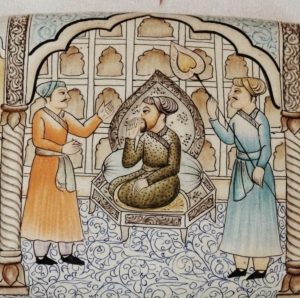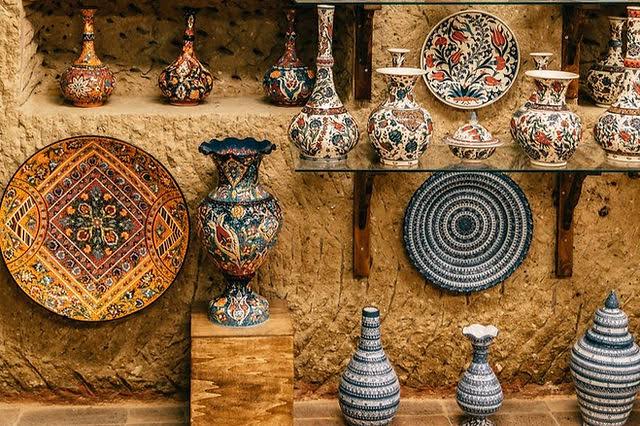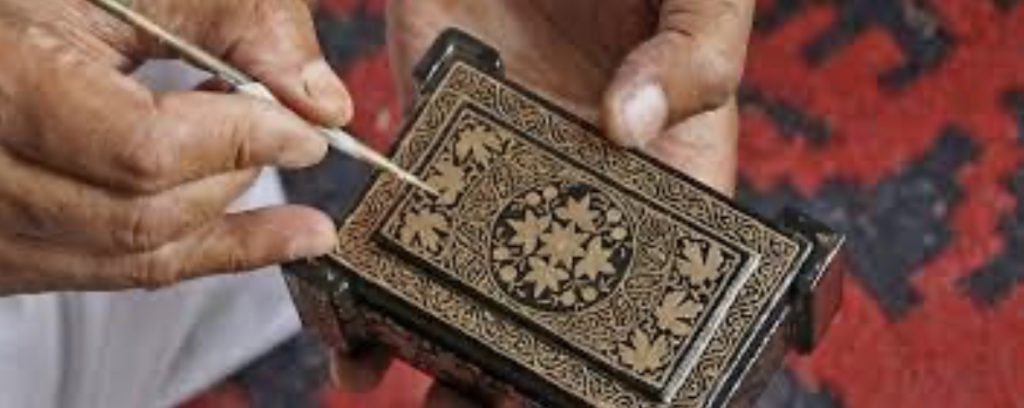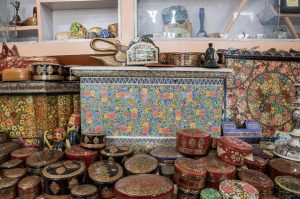The tradition of papier mache has had a long cultural lineage, and its history is linked with the formation of ethnic and religious identities in Kashmir. The beginning of the craft of papier mache is closely associated with the advent of Islam in Kashmir. Islam came to Kashmir in gradual significant phases, and spread mostly through the influence of Sufi pirs. The process was accelerated in the latter half of fourteenth century after Rinchana, a Buddhist prince from Ladakh, converted to Islam and reigned as Sultan Sadruddin, the first Muslim ruler of Kashmir. Papier mache is said to have been brought to Kashmir by the eighth sultan of Kashmir, Sultan Zain-ul-Abidin, from Samarkand in the fifteenth century. However, in the collective memory of the people of Kashmir, the craft and its popularisation is associated with Mir Sayyid Ali Hamadani of Iran, lovingly known as Shah-i-Hamadan. He is said to have come to Kashmir with 700 craftsmen from Iran, who taught the local Kashmiris carpet making, woodwork, papier mache and most of the handicraft work that continues to be practised there till date.
Naqquashi being done on Papier Mache Art
Papier mache craft is largely pursued by the Shia sect of Kashmiri Muslims. They have been the traditional craftsmen engaged with this occupation. A large number of craftspeople trace their ancestry back to the craftsmen who had migrated with Shah-i-Hamadan from Iran. While some have documented evidence to trace their lineage and migration, others rely on stories and legends. A number of craftspeople claim that although they do not trace their lineage to Iran, their forefathers were taught by Persian artists. Thus, in a way, the craft sustains Kashmir’s historical connection and effective ties with Iran.
Who are the Craftspeople?
Papier mache craft making happens in two phases: one set of artists, the sakhtasaz, make the base structure of the craft and then the naqqashi artists work on drawing the designs and polishing the craft. The sakhtasazi and naqqashi artists work closely with each other and the craft is reflective of their needs and desires.
Traditionally, the karkhana (workshop) was also the site where the sale of the craft items took place. This was a strategically important decision for the artists. Sufi states that the Kashmiris took full advantage of the closely housed existence necessitated by the long severe winters, and stimulated cottage industries at home. As the karkhana was located within the premises of the house, female members of the family as well as children would actively participate in the making of the craft. However, over time, there has been a separation between the karkhana and the dukaan (shop). So while papier mache shops are scattered across commercial areas of towns and cities in Kashmir, the karkhanas are mainly concentrated in localities with a majority of Shia population and in the houses of craftsmen. Although the involvement of family members of craftsmen has decreased, they continue to contribute in different capacities. Women usually help with the polishing of end products and velvet layering inside the craft items. Sometimes they also make certain designs, but largely the designing is done by the head craftsman.
The tradition of papier mache has mostly existed as a family occupation. Most artists that I interviewed mentioned being influenced by their fathers and grandfathers into the craft tradition. Although papier mache is usually taught within the family, there are no social rules or prohibitions that advise against incorporation of outsiders into the tradition. Occasionally, people with no history of involvement with the craft choose to learn it for various reasons. Some take it up because of their interest in papier mache, others practise it because of lack of other economic opportunities.
Motifs and Meanings of the Art
Papier mache is called kari munaqqash or painted work. It is also called kariqalamdani or pen-case work, because it was commonly used to ornament pen-cases and small boxes. A characteristic feature of Kashmiri handicrafts is the free exchange of designs and motifs across various craft forms. Designs from wood carvings are painted on objects as papier mache designs. Similarly, designs from shawls and carpets are also emulated on papier mache craft items. The names of the motifs retain their relationship with the object of their inspiration and become known through them. Some of the popular motifs of Kashmir’s papier mache craft are kaleen (carpet), kashan (a carpet design named after a city in Iran), jamavar (a type of shawl worn by the Kashmiris), gul-andar-gul (flower upon flower, indicating the complexity of design), gul-i-hazara (a thousand flowers), gul-e-wilayat (foreign flowers), bagaldar chinar (a type of chinar leaf motif), and gonder (a bunch) designs. Besides these, a number of motifs are used to depict various themes. These may include stories of famous personalities—kings and queens, pirs and mureeds (spiritual seekers), and lovers such as Shirin and Farhad—and political feuds.
Various objects made with Papier Mache technique
Scenes from the Mughal court and from lives of emperors, such as Shah Jahan and Akbar, and stories of Noor Jehan form a category of motifs called Mughal designs. The motifs of elephants and scenes from Indian villages are relatively new and are incorporated because of their popularity with foreign tourists. Motifs of animals and scenes from wildlife form another popular category called jungle design. Philosophical themes, historical episodes and religious stories of public interest also circulate as common motifs. Poetic fantasies form an important element in the formation of motifs as they are largely inspired by the artistic imagination of the craftsperson.
 Scenes from the Mughal Court on Papier Mache Art
Scenes from the Mughal Court on Papier Mache Art
Influences and their Locations
Most of the drawing is done without the aid of any mathematical instruments. Papier mache continues to rely on freehand drawing and painting; however, the practice also borrows techniques from other traditional forms of paintings. One such technique is called abina, where sketches are made by moistening the paint brush with plain water. On drying, the sketch leaves a watermark impression which acts as a guide for the painters who follow. Another significant technique that papier mache has incorporated is the use of an elaborate hashiya (border), often made with gold paint. Hashiya was traditionally the panel on which tasveer (pictures) and the khush-khati (calligraphy) were mounted and then painted. Sufi observes that hashiya would often emerge as a work of art on its own, sometimes vastly superior to the painting itself. The papier mache paintings sometimes have verses from the Quran written in Arabic or Persian poetry written along the length of the hashiya.
The motifs in papier mache works are symbolic of how political history continues to be invoked and memorialised through the craft. Pointing to a papier mache box that has motifs of soldiers mounted on horses playing polo, we can observe that, they are Mongol soldiers playing polo on their horses. On a closer look, one can observe that the soldiers are indeed painted to have Mongol facial features.
The figure of the Mongols emerges from the historical memory of the tradition of the craft. Shah-i-Hamadan, who belonged to the Sayyid community who trace their lineage to Prophet Muhammad, was a contemporary of the Turco-Mongol conqueror Amir Timur (Taimur-i-Leng). The two figures were bitterly opposed to each other over ideological and political differences. In order to quash opposition and further his project of aggrandisement, Amir Timur started persecuting Sayyids in Iran. Historian Fida Mohammad Hassnain relates that since Sayyids claimed to be immune to fire, Tamiur started roasting them in metal furnaces. Various contemporary historical sources hold Shah-i-Hamadan’s conflict with Taimur as one of the reasons for his migration. Thus, the appearance of the motifs of Mongol soldiers is an interesting example of how history is reproduced according to the understanding of the artist.
The papier mache craft became the medium through which artists inscribed the collective memory of a culture and their understanding of how the past came to determine their present. The symbols of the craft transmute into temporal markers that reveal how a community perceives its lineage, identity and political history, and what it chooses to remember and decides to forget.
Picture Courtesy: Abhivyakti
Feature image courtesy: Partha

Contributor








